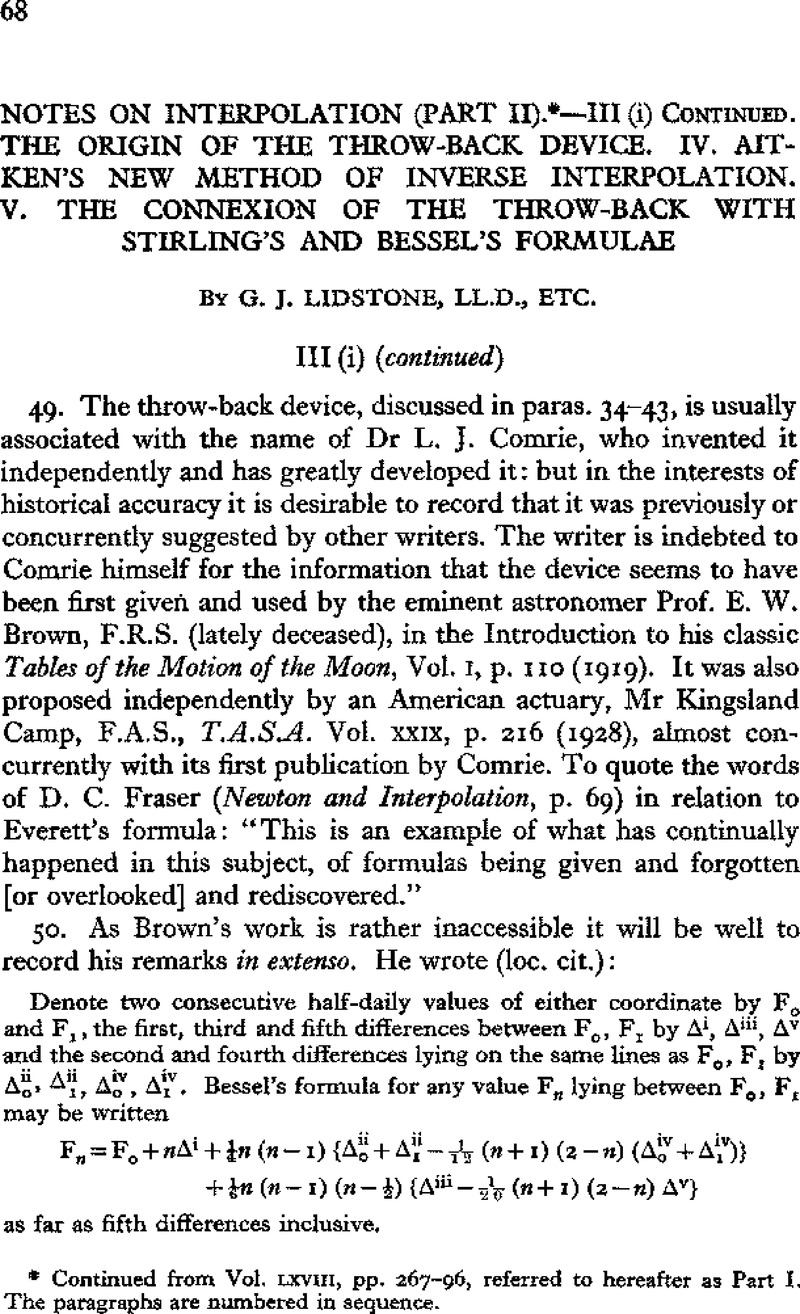Published online by Cambridge University Press: 18 August 2016

page 69 note * It is known that ε 2n and e 2n are the same function of x and (1 − x) respectively: they are of degree 2n+1, while their sum—the coefficient of the mean δ2n in Bessel's formula—is of degree 2n.
page 70 note * Actually the second point makes no difference, for the integrand is an even function, and to minimize ![]() is the same as to minimize
is the same as to minimize ![]() .
.
page 72 note * The paper can be obtained separately at the price of is. 3d. It also contains a method (not here discussed) of forming differential coefficients of successive orders at non-tabular points. [Cf. Comrie, Interpolation and Allied Tables, pp. 803–5].
Note the following erratum:
p. 164. u −3 should read 0.78767 ….
page 72 note † |x| is the modulus of x, i.e. its numerical value without sign. Cf. J.I.A. Vol. li, p. 133.
page 74 note * The process is therefore an iterative one, as to which Whittaker and Robinson (Calculus of Observations, p. 81) say: “A pleasing characteristic of iterative processes … [is] that a mistake … does not invalidate the whole calculation”; though it will visually slow down the approach to the correct result.
page 74 note † It appears from Note A, infra, that v″o ≒ −u″o/u′o.
page 75 note * I.e. when u x is close to u o. This basis considerably increases the maximum tabular error (see Note B)
page 76 note * For example, if we use the system v
1, 2, 3 … with x =. 1 the coefficient of ![]() is
is
while if we bring in v o, i.e. use the system v 0, 1, 2 …, the coefficient is only
Similarly, with the system v ½,… the coefficient is
while if we bring in v o and use the system v 0, ½, …, the coefficient is
page 76 note † This is the example which is worked by Woolhouse's powerful method in the writer's Note, J.I.A. Vol. xlv (1911), p. 491. In this method the values of u′, u″ … are found in terms of differences and the equation expressed as
and the first approximation to t is the appropriate (smaller) root, say ω, of
Then t is expanded in a rapidly convergent series in powers of ω, thus:
The method is systematic and very effective, but it necessitates the formation of differences if not tabulated
page 79 note * In the case of Exs. a and 3, Chap. v of Maths, for Actuarial Students, Part II, the first step (after the first rough trial value) gives the excellent approximations.7646 and.0430 respectively.
page 85 note * The matter in Notes A and B is not contained in Aitken's paper.
page 86 note *
![]() (the and divided difference of the v's); this could be found directly, but is easily seen to have the value given, involving smaller figures.
(the and divided difference of the v's); this could be found directly, but is easily seen to have the value given, involving smaller figures.
page 87 note * It is assumed that an additional place is taken in forming Y, so that the rounding-off of v is not combined and confused with a further rounding-off of Y. The point does not arise with the alternative form
page 88 note * We cannot follow Aitken's statement (loc. cit. p. 172) that the tabular errors of the v's do not exceed ¼ in the 9th place, that is 2½ in the 10th and last place.
page 92 note * The work in the remaining paragraphs may be read in conjunction with Fraser's, D. C. illuminating paper, J.I.A, Vol. 1.(1916), p. 15, and with the writer's paper, T.F.A. Vol. IX (1922), p. 346.Google Scholar
page 92 note † The difference diagram shows that if n is even both GF and GB start with the term u ½n , but if n is odd GF begins with u ½(n−1) and GB with u ½(n+1).
page 93 note * In framing this paragraph the writer has had much benefit from consultation with Mr Fraser.